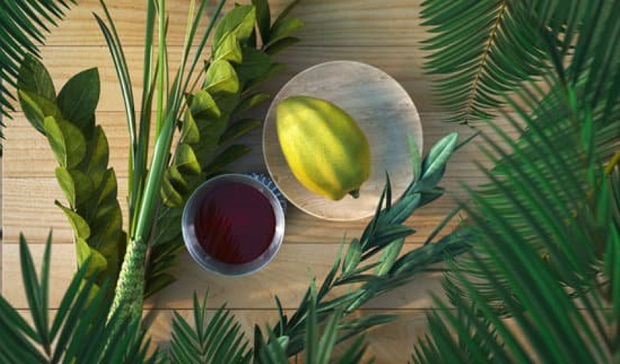Last Updated on October 3, 2025
The symbolism of the Four Species at Sukkot.
Hebrew: Arba’at Haminim – ארבעת המינים
The Four Species include:
- The Palm Leaf – Lulav
- The myrtle – Hadas
- Willow – Aravah
- The Citron – Etrog
During Sukkot they are placed together in a special plaited holder and collectively are known as a as a ‘lulav’. The 4th of the four species, the citron tree or etrog, is held together with the lulav.
There are many elucidations regarding the lulav and etrog. The Midrash (Yalkut Shimoni, Vayikra 247) says that the four species of the lulav represent four different types of Jews:
- The Etrog has a good taste and a good fragrance. It represents a person with both wisdom (Torah learning) and good deeds.
- The Hadas (myrtle) has a good fragrance, but is inedible. It represents a person who has good deeds, but lacks wisdom.
- The Lulav (date palm) is edible, but has no smell. This represents the person with wisdom, but without good deeds.
- The Aravah (willow) has neither taste nor smell. It represents a person with neither good deeds nor Torah learning.
This last category disturbs us. The aravah represents the lowly simple Jew who doesn’t seem to have any virtue. Why is “he” put together with the other three categories of Jews in the Arba’at HaMinim? He doesn’t seem to be worth very much. However, we have to understand that every Jew is very precious. The Gemara (Berachos 57a) states that Klal Yisrael are compared to a Rimon (pomegranate). Even the emptiest one is full of mitzvot (good deeds) like a rimon.
Another interpretation
Each species has a particular reference to G-d,
- According to a Midrash in Leviticus Rabbah, 83: the etrog is symbolic of Psalm 104:1: “You are clothed in glory and majesty”;
- The palm is used because it is said Psalms 92:13: “The righteous bloom like date-palm”
- The myrtle signifies Zechariah 1:8: “And he stood among the myrtle-trees”
- The willow is significant because it is written in Psalms 68:5: “Extol Him who rides on the clouds (aravot), the Lord is His name.”
Also,
Each of the four species signifies a limb of the body and each of these limbs is a means through which man serves God.
- The etrog refers to the heart
- The lulav – the upright backbone
- The myrtle symbolizes the eyes
- The willow – the lips.
There is also a masculine-feminine theme inherent in the four species. The lulav represents masculinity, whilst the etrog is seen as feminine, in its form.
The lulav and etrog must be perfect in every way; therefore, they are chosen with extreme care.
Did you know?
Traditionally, etrogim (plural) grow in Mediterranean lands like Israel, Morocco, Greece and Italy and even as far as Yemen.
When etrogim grow out in the wild, almost all of them are scarred by foliage and animals. So, finding a citron that is evenly shaped and unblemished can be challenging. However, Israeli etrogim are specifically grown for use during Sukkot and so they grown in a controlled and protected environment.



